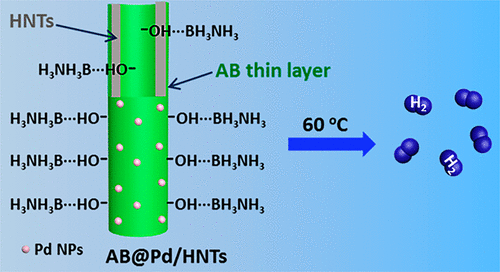当前位置:
X-MOL 学术
›
ACS Sustain. Chem. Eng.
›
论文详情
Our official English website, www.x-mol.net, welcomes your feedback! (Note: you will need to create a separate account there.)
Encapsulation of Ammonia Borane in Pd/Halloysite Nanotubes for Efficient Thermal Dehydrogenation
ACS Sustainable Chemistry & Engineering ( IF 8.4 ) Pub Date : 2020-01-27 , DOI: 10.1021/acssuschemeng.9b04480 Yanan Feng 1 , Xiaopeng Zhou 1 , Jing-he Yang 1 , Xiangyang Gao 1 , Linxin Yin 1 , Yafei Zhao 1 , Bing Zhang 1
ACS Sustainable Chemistry & Engineering ( IF 8.4 ) Pub Date : 2020-01-27 , DOI: 10.1021/acssuschemeng.9b04480 Yanan Feng 1 , Xiaopeng Zhou 1 , Jing-he Yang 1 , Xiangyang Gao 1 , Linxin Yin 1 , Yafei Zhao 1 , Bing Zhang 1
Affiliation

|
Ammonia borane (AB) has been considered as one of the most attractive chemical hydrides for on-board hydrogen storage due to its small molecular weight, high hydrogen storage density, high stability, and nontoxicity. However, the utilization of AB is still restricted by the slow kinetics of H2 release at low temperatures (<85 °C) and simultaneous generation of volatile byproducts. Herein, a new catalytic strategy involving palladium (Pd) catalysis and nanoconfinement in natural halloysite nanotubes (HNTs) for pyrolysis releasing H2 from AB is developed. The results show that AB can be encapsulated into HNTs channels and coated on the surface of HNTs with a uniform nanolayer. The synergetic catalysis of HNTs and ultrasmall Pd nanocatalysts (∼1.4 nm) and the nanoconfinement of AB immobilized on HNTs are beneficial to improving catalytic activities for pyrolysis of AB, which not only avoids emitting byproducts of ammonia, diborane, and borazine but also inhibits usual foaming and expansion of AB during the dehydrogenation process. Meanwhile, the nanoconfinement of AB immobilized on HNTs results in improved kinetics of H2 release at low temperatures of 60 °C, while no H2 evolves from the neat AB at 80 °C. The activation energy of [email protected]/HNTs is 46 kJ mol–1, which is considerably lower than that of neat AB of 183 kJ mol–1. The results show that natural HNTs can be used as economical and efficient supports for fabrication of [email protected]/HNTs hydrogen storage composites, and Pd/HNTs can be used as effective catalysts to improve the dehydrogenation properties of AB.
中文翻译:

氨硼烷在Pd /硅铝石纳米管中的封装以实现有效的热脱氢
氨硼烷(AB)由于分子量小,储氢密度高,稳定性高和无毒性,因此被认为是船上储氢最吸引人的化学氢化物之一。但是,AB的利用仍然受到低温(<85°C)下H 2释放的缓慢动力学以及同时产生挥发性副产物的限制。在本文中,涉及一种在天然埃洛石纳米管(HNT)中钯(Pd)催化和纳米约束的新催化策略,用于热解释放H 2由AB开发。结果表明,AB可以包封在HNTs通道中,并以均匀的纳米层包覆在HNTs的表面。HNT和超小型Pd纳米催化剂(〜1.4 nm)的协同催化以及固定在HNT上的AB的纳米约束作用有利于提高AB热解的催化活性,这不仅避免了氨,乙硼烷和硼嗪的副产物释放,而且还抑制了常规脱氢过程中AB起泡沫和膨胀。同时,固定在HNT上的AB的纳米约束导致在60°C的低温下改善了H 2释放的动力学,而在80°C下没有H 2从纯净的AB释放出来。[受电子邮件保护的] / HNT的活化能为46 kJ mol –1,这大大低于纯净AB的183 kJ mol –1。结果表明,天然HNTs可以用作制备[电子邮件保护] / HNTs储氢复合材料的经济有效的载体,Pd / HNTs可以用作改善AB脱氢性能的有效催化剂。
更新日期:2020-01-29
中文翻译:

氨硼烷在Pd /硅铝石纳米管中的封装以实现有效的热脱氢
氨硼烷(AB)由于分子量小,储氢密度高,稳定性高和无毒性,因此被认为是船上储氢最吸引人的化学氢化物之一。但是,AB的利用仍然受到低温(<85°C)下H 2释放的缓慢动力学以及同时产生挥发性副产物的限制。在本文中,涉及一种在天然埃洛石纳米管(HNT)中钯(Pd)催化和纳米约束的新催化策略,用于热解释放H 2由AB开发。结果表明,AB可以包封在HNTs通道中,并以均匀的纳米层包覆在HNTs的表面。HNT和超小型Pd纳米催化剂(〜1.4 nm)的协同催化以及固定在HNT上的AB的纳米约束作用有利于提高AB热解的催化活性,这不仅避免了氨,乙硼烷和硼嗪的副产物释放,而且还抑制了常规脱氢过程中AB起泡沫和膨胀。同时,固定在HNT上的AB的纳米约束导致在60°C的低温下改善了H 2释放的动力学,而在80°C下没有H 2从纯净的AB释放出来。[受电子邮件保护的] / HNT的活化能为46 kJ mol –1,这大大低于纯净AB的183 kJ mol –1。结果表明,天然HNTs可以用作制备[电子邮件保护] / HNTs储氢复合材料的经济有效的载体,Pd / HNTs可以用作改善AB脱氢性能的有效催化剂。


























 京公网安备 11010802027423号
京公网安备 11010802027423号